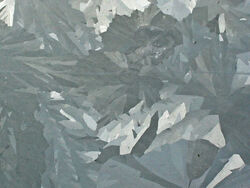
A street lamp in Singapore showing the characteristic spangle of hot-dip galvanization. Author: Chaerani (Meutia Chaerani – Indradi Soemardjan).

Crystalline surface of a hot-dip galvanized handrail.
Overview[]
Galvanization (or galvanizing as it is most commonly called in that industry) is the process of applying a protective zinc coating to steel or iron, to prevent rusting. The most common method is hot-dip galvanizing, in which parts are submerged in a bath of molten zinc.
How it works[]
Galvanizing protects the base metal in three ways:
- It forms a coating of zinc which, when intact, prevents corrosive substances from reaching the underlying steel or iron.
- The zinc serves as a sacrificial anode so that even if the coating is scratched, the exposed steel will still be protected by the remaining zinc.
- The zinc protects its base metal by corroding before iron. For better results, application of chromates over zinc is also seen as an industrial trend.
How it is done[]
The size of crystallites in galvanized coatings is a visible and aesthetic feature, known as "spangle". By varying the number of particles added for heterogeneous nucleation and the rate of cooling in a hot-dip process, the spangle can be adjusted from an apparently uniform surface (crystallites too small to see with the naked eye) to grains several centimetres wide. Visible crystallites are rare in other engineering materials, even though they are usually present.
Hot-dip galvanization is a form of galvanization. It is the process of coating iron and steel with a layer of zinc by immersing the metal in a bath of molten zinc at a temperature of around 840 °F (449 °C). When exposed to the atmosphere, the pure zinc (Zn) reacts with oxygen (O2) to form zinc oxide (ZnO), which further reacts with carbon dioxide (CO2) to form zinc carbonate (ZnCO3), a usually dull grey, fairly strong material that protects the steel underneath from further corrosion in many circumstances. Galvanized steel is widely used in applications where corrosion resistance is needed without the cost of stainless steel, and can be identified by the crystallization patterning on the surface (often called a "spangle").
Galvanized steel can be welded; however, one must exercise caution around the resulting toxic zinc fumes. Galvanized steel is suitable for high-temperature applications of up to 392 °F (200 °C). The use of galvanized steel at temperatures above this will result in peeling of the zinc at the inter metallic layer. Electrogalvanized sheet steel is often used in automotive manufacturing to enhance the corrosion performance of exterior body panels; this is, however, a completely different process which tends to achieve lower coating thicknesses of zinc.
Like other corrosion protection systems, galvanizing protects steel by acting as a barrier between steel and the atmosphere. However, zinc is a more electropositive (active) metal in comparison to steel. This is a unique characteristic for galvanizing, which means that when a galvanized coating is damaged and steel is exposed to the atmosphere, zinc can continue to protect steel through galvanic corrosion (often within an annulus of 5 mm, above which electron transfer rate decreases).
Hot-dip galvanizing deposits a thick robust layer of zinc iron alloys on the surface of a steel item. In the case of automobile bodies, where additional decorative coatings of paint will be applied, a thinner form of galvanizing is applied by electrogalvanizing. The hot-dip process generally does not reduce strength on a measurable scale,[3] with the exception of high-strength steels (>1100 MPa) where hydrogen embrittlement can become a problem. This deficiency is a consideration affecting the manufacture of wire rope and other highly-stressed products.
The protection provided by hot-dip galvanizing is insufficient for products that will be constantly exposed to corrosive materials such as acids, including acid rain in outdoor uses. For these applications, more expensive stainless steel is preferred. Some nails made today are galvanized. Nonetheless, electroplating is used on its own for many outdoor applications because it is cheaper than hot-dip zinc coating and looks good when new. Another reason not to use hot-dip zinc coating is that for bolts and nuts of size M10 (US 3/8") or smaller, the thick hot-dipped coating fills in too much of the threads, which reduces strength (because the dimension of the steel prior to coating must be reduced for the fasteners to fit together). This means that for cars, bicycles, and many other light mechanical products, the practical alternative to electroplating bolts and nuts is not hot-dip zinc coating, but making the fasteners from stainless steel.
Thermal diffusion galvanizing, or Sherardizing, provides a zinc diffusion coating on iron- or copper-based materials. Parts and zinc powder are tumbled in a sealed rotating drum. Around 300 °C (572 °F), zinc will diffuse into the substrate to form a zinc alloy. The advance surface preparation of the goods can be carried out by shot blasting. The process is also known as "dry galvanizing", because no liquids are involved; this can avoid possible problems caused by hydrogen embrittlement. The dull-grey crystal structure of the zinc diffusion coating has a good adhesion to paint, powder coatings, or rubber. It is a preferred method for coating small, complex-shaped metals, and for smoothing rough surfaces on items formed with sintered metal.
Galvanized piping will eventually need to be replaced if housing stock is to outlast a 50 to 70 year life expectancy, and some jurisdictions require galvanized piping to be replaced before sale.
Also see[]
- Useful metals
- Cupronickel (also known as copper-nickel)
- Depleted uranium
- Tungsten carbide (chemical formula: WC)
- Tungsten-steel
- Thoriated magnesium (AKA- Mag-Thor)
- Minerals and fuel in central Africa
- Mineral mining, smelting and shipping videos
- What is an 'alloy'
- Minerals and fuel in central Africa
- Mineral mining, smelting, processing and shipping videos!
- Today's OTL types of economies, societies and regimes
Sources[]
- http://www.thefreedictionary.com/galvanising
- https://en.wikipedia.org/wiki/Hot-dip_galvanization
- http://www.technologystudent.com/equip_flsh/galv1.html
- http://www.nepean.com/building/products-services/galvanising/what-is-the-galvanising-process%3F
- http://www.korvestgalvanisers.com.au/galvanising-process/
- http://www.thefreedictionary.com/galvanise
- https://www.merriam-webster.com/dictionary/galvanise
- https://en.wikipedia.org/wiki/Galvanization